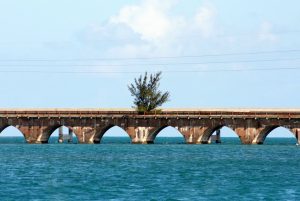
A welcome sight cheered weary Florida Keys locals returning home this week after Hurricane Irma struck the islands Sept. 10. His name is “Fred.”
He’s a salt-sprayed Casuarina, known locally as an Australian pine tree. Fred is growing out of a roadbed on the historic Seven Mile Bridge, built in 1912 as part of the famed Florida Keys Over-Sea Railroad.
And Fred survived Irma.
Other Irma survivors Key West and Key Largo are rebounding quickly. Key West International Airport is open, a cruise call is set for Sunday in Key West and Keys hotels are working to reopen. Attractions, restaurants and bars are digging out as well.
But Fred, a non-native species, symbolizes the resilience of Keys residents determined to restore what Irma tried to blow away.
Fred may have sprouted from droppings of a migrating bird or local osprey, speculated a 2013 story in Keys Weekly.
The tree is “only reachable by parachute, jetpack or by scaling a 100-year-old pylon from a boat bobbing in the water more than 20 feet below the roadbed,” the story states.
A smaller tree, just to the west of Fred, has been dubbed “Fred Jr.”
Every December locals decorate Big Fred with lights for the holidays.
In-the-know locals and visitors post Facebook comments to Fred, and Fred responds. Among recent post-Irma messages to Fred:
“You’ve got some good roots.”
“You are a Warrior.”
“Fred is Keys strong.”
“Can’t wait to see you lit up for Christmas!”
And, “If Fred can survive, we can all survive and prosper.”
That is how Fred inspires Keys residents — as a symbol of both the region’s resilience and its quirkiness — a tough little tree surviving in the unlikeliest of places.